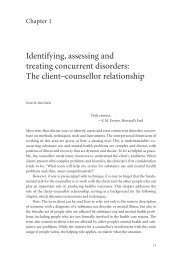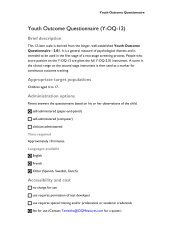Clinical Supervision Handbook - CAMH Knowledge Exchange ...
Clinical Supervision Handbook - CAMH Knowledge Exchange ...
Clinical Supervision Handbook - CAMH Knowledge Exchange ...
You also want an ePaper? Increase the reach of your titles
YUMPU automatically turns print PDFs into web optimized ePapers that Google loves.
<strong>Clinical</strong> <strong>Supervision</strong> <strong>Handbook</strong><br />
In another study, Constantine, Warren and Miville (2005) present and discuss the use<br />
of the multicultural case conceptualization ability exercise, a tool and coding system<br />
used to determine the extent to which clinicians are able to integrate salient cultural<br />
issues into two different conceptualizations of a client case.<br />
Finally, Pope-Davis and colleagues (2000) describe the development and validation<br />
of the Multicultural Environmental Inventory—an instrument designed to measure<br />
the degree to which graduate counselling programs address multicultural issues in<br />
their curricula, clinical supervision, climate and research. The instrument was condensed<br />
from 53 to 27 items based on the results of factor analyses, and showed promise<br />
in its ability to assess change over time, as well as good validity and reliability. Although<br />
designed for academic settings, it may be useful to test either the instrument as a whole,<br />
or the supervision subscale, as a way to evaluate clinical supervisors’ effectiveness in<br />
addressing and promoting cultural competence in clinical supervision groups.<br />
Cultural and diversity competence is now being addressed in a more rigorous fashion<br />
in clinical supervision settings. This reflects a growing awareness of their importance,<br />
and of the need for ways to assess and identify gaps in knowledge and skills (both in<br />
clinical supervisors and in front-line clinicians).<br />
CLINICAL SUPERVISOR EVALUATION<br />
Providing and accepting clear and concrete feedback, identifying strengths and areas<br />
for improvement, and specific concerns with respect to good clinical care can be<br />
difficult for both clinical supervisor and clinician. Yet “when supervisees reflect on<br />
their supervision, what comes to mind most often is the quality and quantity of<br />
feedback they received” (Bernard & Goodyear, 1998). Therefore, clinical supervisors<br />
need to evaluate the extent to which they are providing constructive and salient<br />
feedback to clinicians.<br />
Heckman-Stone (2003) carried out a pilot study with 40 graduate students from<br />
three training programs (counselling psychology, clinical psychology and masters<br />
degree in counselling). She used a scale of 10 items rated on a seven-point, Likert-type<br />
scale, where 1= strongly disagree, 4 = neutral, and 7 = strongly agree. In addition,<br />
the author included four open-ended items designed to elicit examples of positive<br />
and negative feedback in clinical supervision, and the characteristics of good<br />
and poor use of feedback and evaluation by clinical supervisors. An example of<br />
the instrument, adapted for use with more experienced clinicians—as opposed to<br />
92

















